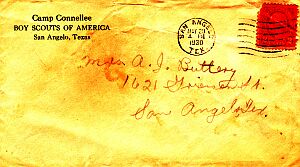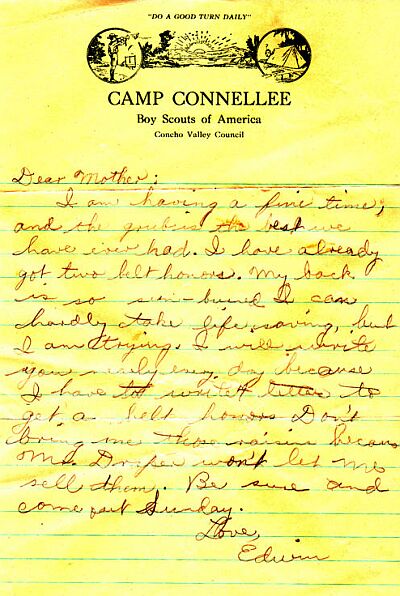 |
Other Camps of the Concho Valley CouncilThere were many different summer camps held in the Concho Valley Council from 1922 till they went to Camp Louis Farr in 1929. In some summers, they held a camp at the beginning of the summer and another camp at the end of the summer. Here are those camps. Camp Vista ConchoMembers of the Kiwanis Club furnished transportation. Sam Crowther, first Kiwanis Club President and Chairman of the Scout Camp Committee, accompanied the youth to the camp. There were eight patrols of eight youth each and for each patrol there was a Scoutmaster. Each patrol occupied a separate tent. Swimming, games, instruction in Scoutcraft, diving, life saving, fourteen mile hikes and exercises were part of the program of camp. The idea for a Boy Scout Band came out of this encampment. The proposition was submitted to the boys in camp and a large number signified their desire to enlist as musicians. Upon completion of the camp the Scouts marched down Chadbourne street. "This first Scout camp was a wonderful success in every way and will be made an annual affair", said Mr. Compton. "The boys not only benefited from instruction in Scout tactics, but they learned much in the way of comradeship, fair play, politeness, and other admirable qualities." Next Year at ChristovalThe camp lasted for five days. The camp, which they said was both recreational and educational was in charge of the Rev. J. H. Garrett, pastor of the South Side Baptist Church and Scoutmaster of Troop No. 2, assisted by the Rev. J. A. Richardson, pastor of the Methodist Protestant Church and Scoutmaster of Troop No. 3. Other assistants who attended the camp were Mart Findlater, Scoutmaster of Troop No. 1; Gene Cornelison, No. 4, and Morgan Jett, No. 7. The camp was under the auspices of the Kiwanis Club. the meals were cooked in the restaurant building on the grounds and the boys slept in the open, taking shelter under the main tabernacle in case of rain. The Scouts participated in a daily program each of the five days of the camp. Setting-up exercises, drills, inspections, water sports, baseball and other games were staged daily. Each day three talks were given to the boys by San Angel men. Much time was given to daily examinations for advancement in scoutcraft and for merit badges, thirty-eight of which influence steady application in a wide range of subjects. The Scouts also competed for the troop banner, the award of which was based upon each troop's record during the five days. Troop No. 2 has the possession of the banner, having won it last year. The Scouts were guests of Mr. and Mrs. William Anson at their Head-of-the-River ranch above Christoval at a barbecue at noon on Friday. The boys biked about four miles in the rain but the trudge only whetted their appetites for the barbecue mutton, frijole beans, pickles, onions, bread, and watermelons. The rain had ceased by the time they reached the ranch. Camp Geronomino I & II
They white washed the rocks around the tents and Bob Weston spilled lime all over himself. In addition, Keith Arnold killed a skunk in his campsite which stunk up the site for a couple of days. A veterinarian cut up a dog after putting it to sleep, to show the Scouts the various inner parts. The camp patch was felt, shaped like an arrowhead and had a "G" on it. It was red with a green "G." Geronimo II was held September 9-14, 1926 just before school started. The Scouts went to camp on Thursday in ten trucks piled high with baggage and boys. The group was involved in the program for fifteen hours of work and play each day. J. T. Sorrels erected a huge mess hall that would accommodate over 200 at one time complete with tables and benches. The
Eagles, headed by Bormar Horton, on Saturday morning
won the inspection. Then the group hiked about
nine miles down the South Concho River to a big
swimming hole. Later that afternoon, the boys
turned Chinaman and did what washing was
required. On Tuesday night the Scouts served
barbecue to the Liion's club. The club, in
turn, passed our Eskimo pies twice to the Scouts. Camp Pomel
Camp Pomel was located 18 miles up
the beautiful San Saba River from Menard, te County
seat of Menard County, Texas. It was
four miles from Fort McKavett, one of the earliest
forts of the United States. The camp
property adjoins the major highway and is only a
30-minute drive from Menard. The
altitude of the camp is 2,220 feet and is in the
wooded section of West Texas. Camp Pomel
consists of 1,700 acres. The camp building was on a grassy
knoll above the largest nature lake in West Texas. The lake
is just four miles below the huge head spring of the
San Saba River, rising out of the crystal pools in
the mountains making it clear and pure. The lake
is over a mile long and two blocks wide with depths
from 2 feet to 15 feet for all kinds of sports. The camp
faced the lake for a mile and the forest of gigantic
pecan and oak trees covered more than a hundred
acres making it proverbial fairy land of natural
beauty. The
summer camp ran from July 1 to August 15, 1927. Go HERE for
more detailed information on Camp Pomel. Camp Kickapoo
The photo to the right is of the mess hall at Camp Kickapoo taken in 1928. Left to right: Dick Stengel and Edward L. Mears of Menard and Bill Byrd of San Angelo. Dwight Hunter, Jr. and J. T. Henderson both told this story to the author so it must be true. K. N. Clapp, one evening during the campfire program that he was leading, suddenly, without explanation, started taking off his Scout shorts and then his underwear right in front of everyone! Everyone in the audience was horrified until Clapp explained to the Scouts that a stinging scorpion was in his pants. Hunter said that Clapp was very upset at the Scouts because he just knew that one of them had put the scorpion in his shorts. However, according to our two Scout who told this story, this was not true; the scorpion apparently crawled into hs short before he put them on for the campfire or while he was siting down at the campfire. Camp ConnelleeThe Scouts stayed in eighteen tents, stretched on both sides of the river. There were three miles of river front and two swimming holes, one for beginners and one for swimmers. The first camp period of 150 Scouts were divided into two groups - the David Crocketts and the Kit Carsons. Here is a letter that was sent home by Edwin Buttery to his mother:
Camp Louis FarrCamp FawcettCamp Sol MayerThe deed stated “As part of the consideration hereinafter described lands shall never be sold, mortgaged nor hypothedated and shall never be leased for oil, gas or other minerals. This land shall be used as a camp for Boy Scouts of America and for no other purpose; but such camp can be used by the Girl Scouts on occasion and at intervals, with the consent of the officers and director of the Concho Valley Council of the Boy Scouts of America.” The deed was dated August 18, 1945. During a meeting of the Council Executive Board, October 6, 1945, Sol Mayer reminisced that the site of the camp was his old stomping ground when he was ten years of age, he remembered catching a 62 pound fish in the San Saba River near the site and had a hard time getting it into Menard. The first
event held on the newly accuired property was the
Council Executive board which met on the camp
property on October 6, 1945. The first large
scale event to be held on the new property was in
May, 1946, when the council held a council-wide
camporee attended by 350 Scouts and leaders.
During May 1946, the first large-scale Scout
activity was held when 350 Scouts and leaders held a
council wide camporee on the site. For a
detail description of this camp's history go to: Camp Sol Mayer.
Information for this page came from Panjandrum A History of Scouting in the Concho Valley Council 1911 - 2002 by Frank T. Hilton, 2001. We want to thank Alison Barton for sending us the letter from Edwin Buttery to his mother. Last
Updated: April 27, 2024 |

